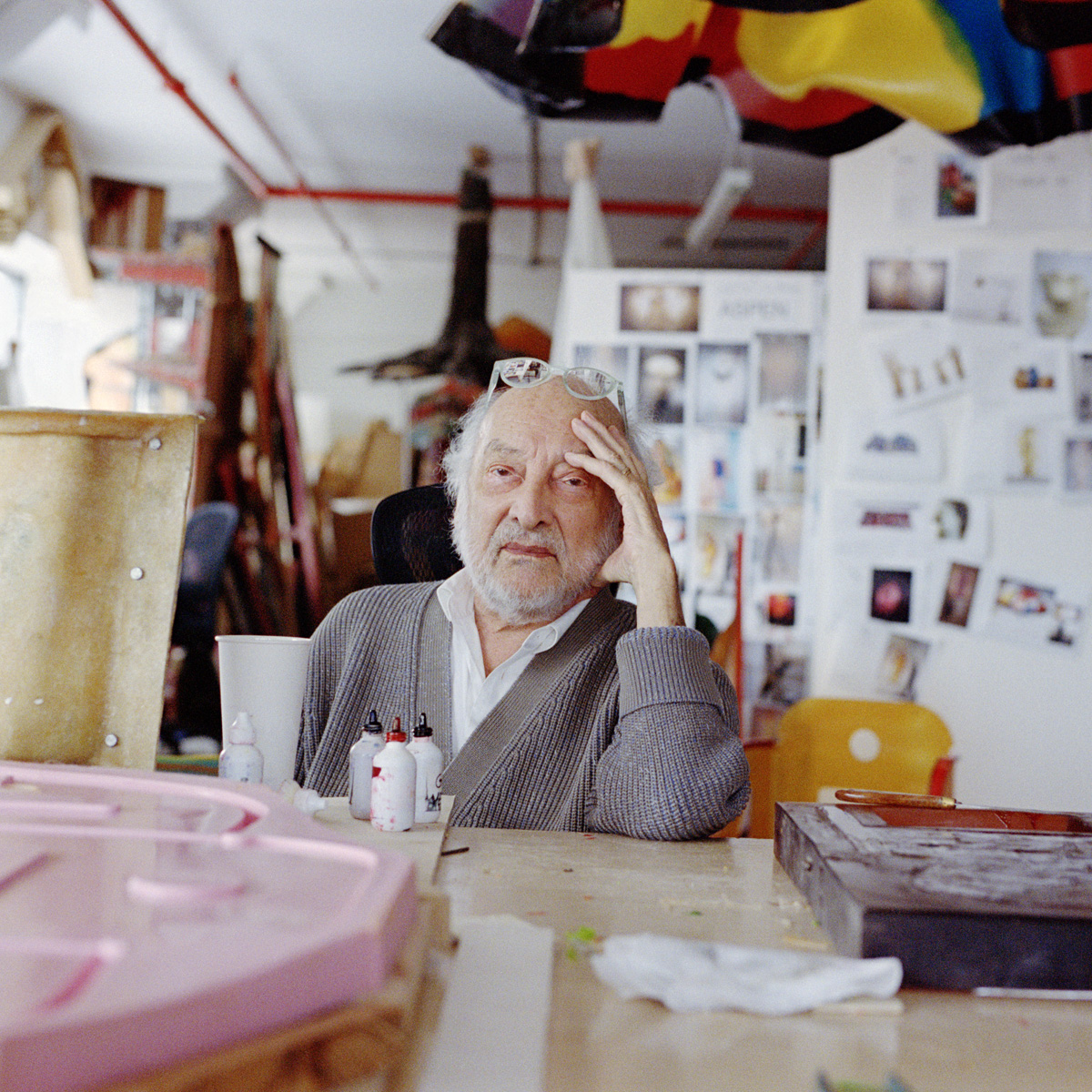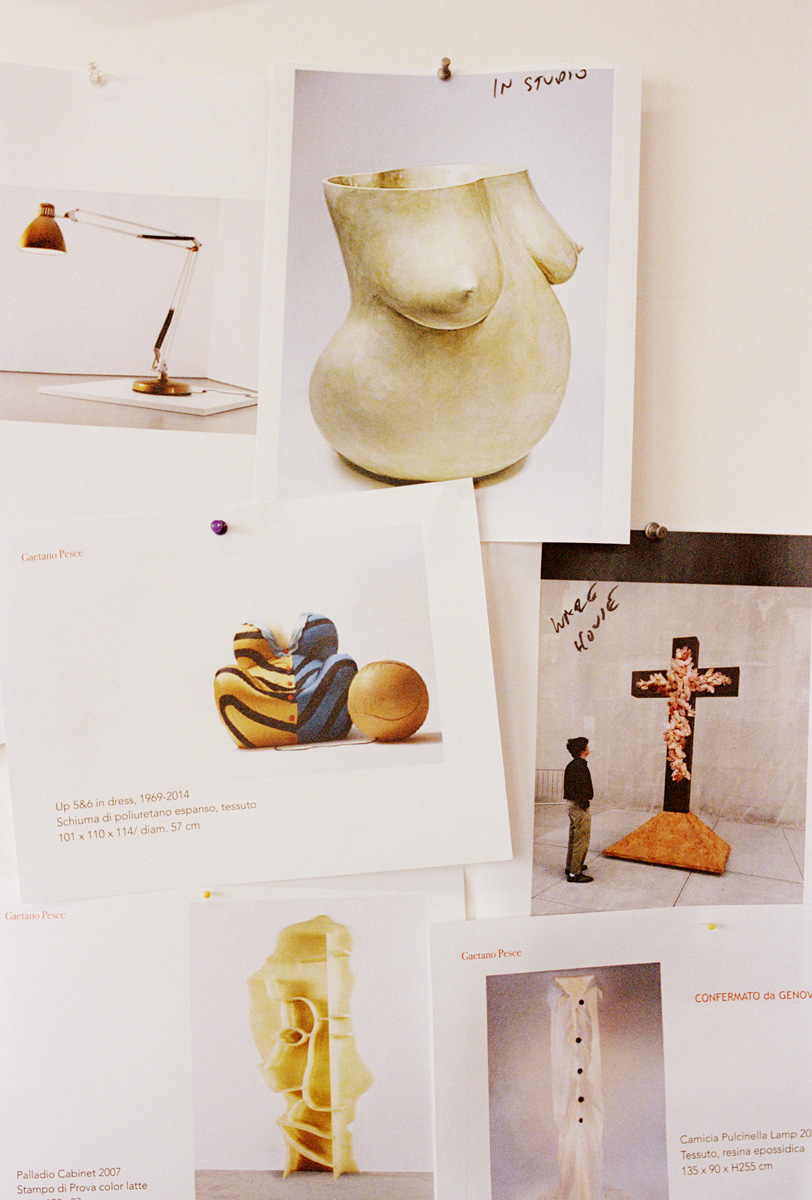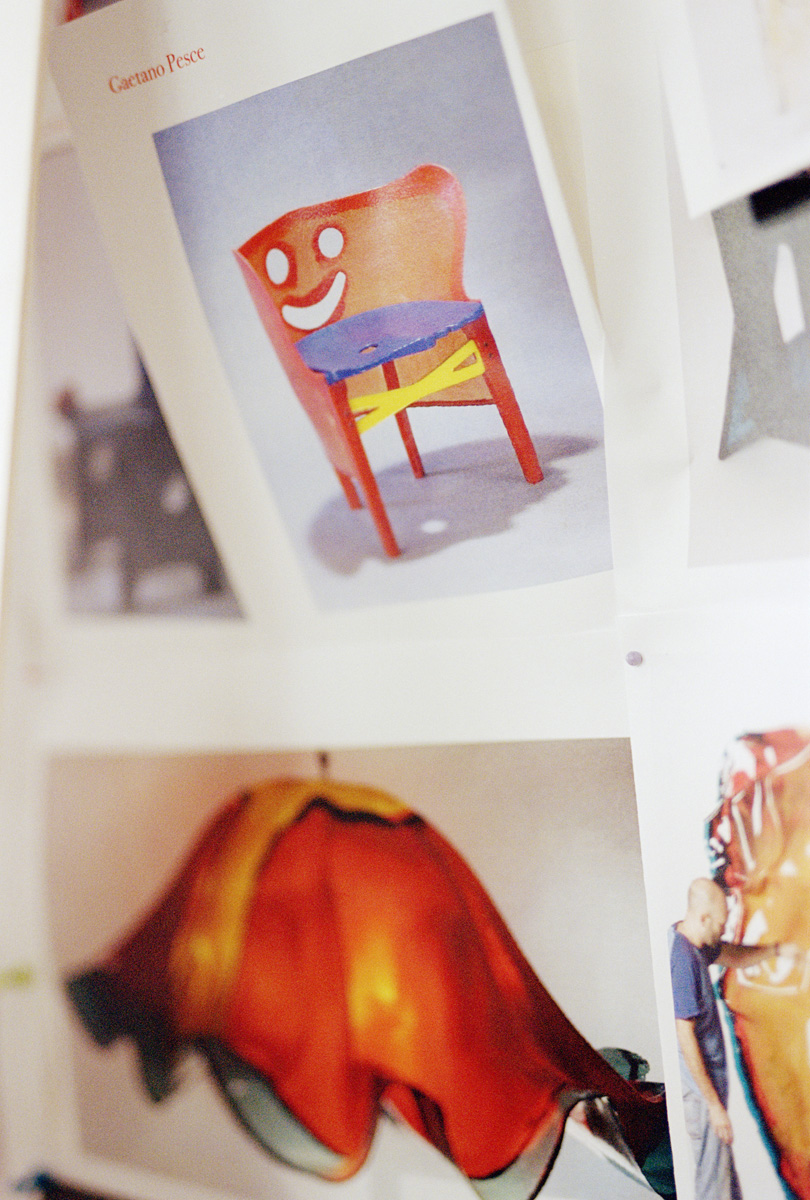Breakfast with designer Gaetano Pesce
at his studio in Brooklyn, New York
Conversation with Carlotta Tonon Rubini Photography Jody Rogac

-
CTRWe really miss travelling. I don’t want to fall into rhetoric here. Your life has been punctuated with movement and travel; you have visited and lived in many different places, not least your hometown of La Spezia, which is a port town. Is it merely narrative whim that gives me the impression you might be feeling the need to get away?
-
GPI think that when we are born somewhere, the best thing to do once you’ve got to know it is to go out and discover other places, because the diversity of the world elevates our mind and helps us understand things. And it probably makes us tolerant too. Understanding other people is almost a duty because other people always have something to tell us – places always have something to tell us – and they can enrich our mental sphere. If I could give any piece of advice to our leaders, it would be that they should get to know the world. Years ago, I met a Brazilian politician who really made me think. He told me that politicians should have, above all else, a passport full of stamps. This would mean that the passport had visited many different places and encountered different identities, people and ways of looking at life and therefore that the politician would lead with the experience borne of those travels. This is very important.
-
CTRWhat were you like as a boy?
-
GPI was a solitary, taciturn boy. I once overhead my mother talking to a friend about me and she said, “Gaetano is somebody who listens”. I do prefer listening to talking. I’m sharing my thoughts now but I’d be happier listening to somebody else. In any case, it’s very important to listen in order to absorb different points of view, which we need for everything we do. It is especially important for creatives to have an inner richness that is then represented in what we do, which can be called art. Potentially. My mother was a pianist and when I was 16 or 17, she saw me drawing and suggested I go to architecture school because she maintained that it was the main art. Music is a very complete art but architecture has it all: when you walk into a space and make a noise, that’s music; when you look at a wall, that’s the canvas, when you look at something three–dimensional, a corner perhaps, that’s sculpture; if you move around, that’s cinema. And so on and so on... So architecture is the main art. And I was more than happy to go to a school that was of little use to me but where I could breathe in this extraordinary art and understand it... And understand the enormous difference between architecture and decoration. Architecture is extremely rare. Take New York, we’ve only got one piece of architecture and that’s Frank Lloyd Wright’s Guggenheim. All the rest is just repetition.
-
CTRYou decided to study Architecture at IUAV University in Venice followed by post–graduate studies at the Industrial Design School in Padua. What influence did these schools have on your training?
-
GPI went to Venice and then to Padua. I went back and forth in train and I would travel in the luggage rack to avoid paying for a ticket. I had realised that the ticket inspector never looked up, only down. One day I saw a woman looking at me. She became my partner. An exceptional woman. She was studying at the first Italian design school, incredibly. So I attended as a listener because I would accompany her. Milena. She showed me that design is an extremely important form of expression to cultivate and keep an eye on which I didn’t know at the time. At the same time, I was studying architecture where the professors just taught me what they had learned when they were young: it wasn’t right for me, I was a boy looking at life later than them. The only teacher that was important for me was called Bruno Zevi and he taught the history of architecture. He made me realise that time is extremely important. As time changes, our values change, so if you don’t follow the new values, you become a reactionary and that is what makes me think that many of the so–called progressive political parties don’t actually evolve or move with the times. They are convinced they are progressive but the truth is that they are ridiculous reactionaries. They are often dangerous reactionaries too. In any case, getting back to Venice, I would go there and listen to Rogers or Scarpa. The history of architecture is extremely complex, Carlotta. These great architects would come to the school as guest lecturers. Alvar Aalto came. We students were very interested in the extraordinary presence of this Scandinavian and deserving designer. In any case, he was late to the lecture, we were all waiting, the hall was full; he eventually turned up and declared in French, “l’architecture est très difficile.” And then he left. We thought he’d come back but no, he didn’t come back. He’d given his lecture in four words. Architecture is, in fact, difficult. We toss the term architecture about too carelessly nowadays. Art is synonymous with freedom, curiosity, research, surprise and discovery. This is art, Carlotta. Prison is the opposite. Prison is total obscurantism and lack of liberty.
-
CTRThe odd inflection betrays an accent that I know very well...
-
GPVenice is a beautiful city, it was a wonder in the past. There are some masterpieces in Venice, the Doge’s Palace is one of them, from an architectural point of view.
-
CTRVenice turns 1,600 years old today.
-
GPI love it, I hope it continues to exist because it is an institution. It is unique in the world and it is an organic jewel. Nobody has ever used the word “static” to talk about Venice.
I was a solitary, taciturn boy. I once overhead my mother talking to a friend about me and she said, “Gaetano is somebody who listens”. I do prefer listening to talking. I’m sharing my thoughts now but I’d be happier listening to somebody else.

-
CTRWe were talking about teachers...
-
GPAt school, when Zevi would make me study churches, I would copy the architecture of Borromini or Michelangelo. My teachers were called Michelangelo, Masaccio, Giotto – I visited the Scrovegni Chapel in Padua countless times in an attempt to understand how this Tuscan “wretch” could have imagined such a wonder. The same applies to Dante Alighieri, how did these “country folk” manage to create things that remain unrivalled to this day? How? This is human intelligence. The contradictions of Michelangelo were valuable lessons for me: we can’t be consistent because consistency is boring. Consistency means not moving with the times and, as I said, moving with the times brings different and even contrasting values. So we can’t be consistent but we can be inconsistent. This also creates a form of freedom and it is a freedom that allows us to grow, to abandon yesterday’s mindset and take on the mindset of tomorrow.
-
CTRYour research initiates a completely new language, quite literally, that manifests precise intentions: programmed art, serial art, kinetic art. Can you tell us about this first journey? You use sound, movement, light and different materials to experiment with formal interpretations that are not traditional or obvious. We have seen a lot of your work and like to think that we grasp its freedom and hybrid nature.
-
GPWhen I was 18 years old, I joined an art group with a group of friends. Programmed art at the time was a sort of visualisation of geometric shapes, things in movement... I made objects with smoke, I was interested in its movement. A few years later, I realised that this art was completely detached from reality because it was a way of expressing oneself through static and repetitive geometry, so I left the group. I use sound and movement, it’s true, everything that can be used in art is usable. From light to movement and materials. All of it. Everything that is life, above all, is part of the representation of art and so I would say there are no limits. There’s something else to think about too: you can use methods from the past to make art today. We choose contemporary clothes, we don’t go around with a sword on our hip and a helmet on our head. I came to the studio by taxi not on horseback. Just as certain things have evolved, so have methods in the art world evolved and you have to chose today’s tools if you wish to be honest in your work and honest with the people who look at it and use it. That is why I use liquid materials that blend together and then get hard or remain elastic, depending. This is a liquid age. The values of our era rise and fall like the waves, they disappear and the material resembles this. They are liquids that are eventually all put together in the oven – although often I don’t even put them in the oven. They harden alone and, if I want, some might remain elastic while others become rigid. I didn’t learn anything about contemporary materials at school. I wrote to chemical companies and they allowed me to see what they were doing with contemporary materials and that was an important revelation for me.
-
CTRThere is a poetic freedom in bringing together arts and knowledge to create more. Am I right?
-
GPYes, that’s probably the way it is. The more complex the knowledge, the more complete the art. That’s what I would say.
-
CTRCould you tell us about how you ended up in America, where you have lived since ’83?
-
GPI lived with my family in Paris for 14 years and we moved to New York. It was 1983, so 41 years ago. I think it was a good move because New York certainly isn’t a provincial metropolis. It is a city composed of things that really interest me such as diversity and minorities that exist and maintain their identity, thankfully. New York constantly teaches us the quality of difference, which is very important.
-
CTRIs that desire to abolish the disciplines of art, architecture and sculpture the way that Leonardo, Raphael and Michelangelo did, still your “Renaissance” when you design? It is something that I find very powerful.
-
GPDisciplines will always exist. The important thing is not to get stuck on one discipline. When they made the dome for Florence Cathedral, they awarded a prize to a goldsmith who lived in Rome: Brunelleschi who was born in Florence but worked as a goldsmith in Rome and had never done any architecture in his life. That goldsmith had techniques that were clearly useful in creating the dome... We are still in awe of its structure today. Knowledge of different disciplines is extremely important.
-
CTRAn armchair of yours, the UP5, which has been nicknamed “Woman” because it recalls the female body, my body, offers a feeling of protection, it invokes birth and fertility. Is it right to recognise this political statement in your work and to associate it with the word “emancipation”?
-
GPI had the good fortune to reflect on this when I was 28 years old. I have always had a lot of female friends, not as many male friends because I find they are often boring and repetitive whereas women always have surprising perspectives, I have learned a lot from them. What exactly? I have learned that, sadly, women suffer because of men, because of prejudice and old mindsets. In many countries, women are even prisoners, in others they live with the uncertainty that they might lose their life one day to the next, including Italy. Reflecting on this, I decided to adopt a non–traditional approach, I decided to do it with an armchair. Nobody had ever said that an object can also be a political object, a political message. So we come to the point, which is worth reiterating: design that follows the dictate of “form and function” is now outdated. So how do we refresh it? The only way is to expand its territory into the field of art. If an object provides function or comfort or something practical, it is correct, but if it also communicates a religious belief, a political or existential stance – anything at all – then it becomes more like a sculpture and it makes you reflect. If I design an object that makes you think, it is mass–produced so that it can reach as many people as possible and perhaps the message will spread more quickly. To my mind, an armchair that criticises the fact that women are victims of male prejudice and stupidity might be useful. I made it 51 years ago and it was the first political object on the Italian design scene. And when I say Italian design, I mean global design because Italian design is still the most profound, the best and the most interesting to this day.
There is no art that is not innovation. Art is always innovation otherwise it isn’t art. It is very simple. Art is discovery, art is starting new forms.

-
CTRYou have known many generations of women. I believe that you have provided precise thinking in this representation of us. What do you think of activism today? Do you recognise that the patriarchy is still an unsolved issue? That there is still much to do “for diversity” in its freest forms?
-
GPI think many women are interesting. Fernanda Pivano, wife to Sottsass, was much more intelligent than Ettore, for example! [laughs] She was a very modern woman. Just like Oriana Fallaci. A great woman. There are also many very talented and intelligent female architects but where a man works hard, a woman has to work 30 times as hard so that must be considered as well. Women are much closer to the nature of our time. Men are tired. They belong to the past, in a certain sense, because they see things straight and straight lines aren’t that useful. We need curves because they reveal different angles and give us a lot precisely because they aren’t straight. We keep these women who have so much to say away from leading the world. This is terrible! If we don’t give leadership of the world to women, the current very serious crisis will never be resolved. That is my opinion.
-
CTRThank you for your words, Maestro. You have stated, and I believe, that your work is intimately linked to a need for innovation.
-
GPThere is no art that is not innovation. Art is always innovation otherwise it isn’t art. It is very simple. Art is discovery, art is starting new forms. Art evolves in contrast with the art that came before it, it’s not science. In science, every discovery is based on the one before, art functions by opposition. In the years of art informel, we started doing rational art to go against it.
-
CTRI have had the impression for some time now, that we are living in an age of transformation. And that what we are currently living through is an acceleration this change, which although slow was already underway. I am referring in particular to the pandemic.
-
GPOf course, all ages are, Carlotta. All ages are of transformation! Having said that, perhaps things are moving faster now because we have so much technology to help us move faster. As for what is happening at the moment, it did not happen by chance. The world is on its knees and this will probably change the future.
-
CTRWe are all actors nowadays, we can hide, refuse or work together to make something concrete. Do these thoughts apply to your work? How so?
-
GPYes, this can probably be applied to my work but I don’t work simply by following the first thought that pops into my head when I go to sleep at night or wake up in the morning. I am surprised by many of the things I do, I don’t know where they come from. Certain observations that develop into projects amaze me and sometimes I only understand the significance of certain things two or three years after I make them and that is because we allow ourselves to move with time, which is something very close to the divine in my opinion... Time is divine and if you draw close to this divinity, it gives you things that we can’t even imagine. That’s where creativity comes from. If we know time well, it gives us the chance to create things that are useful for the world.
-
CTRThank you very much, Maestro. GP See you around somewhere.
